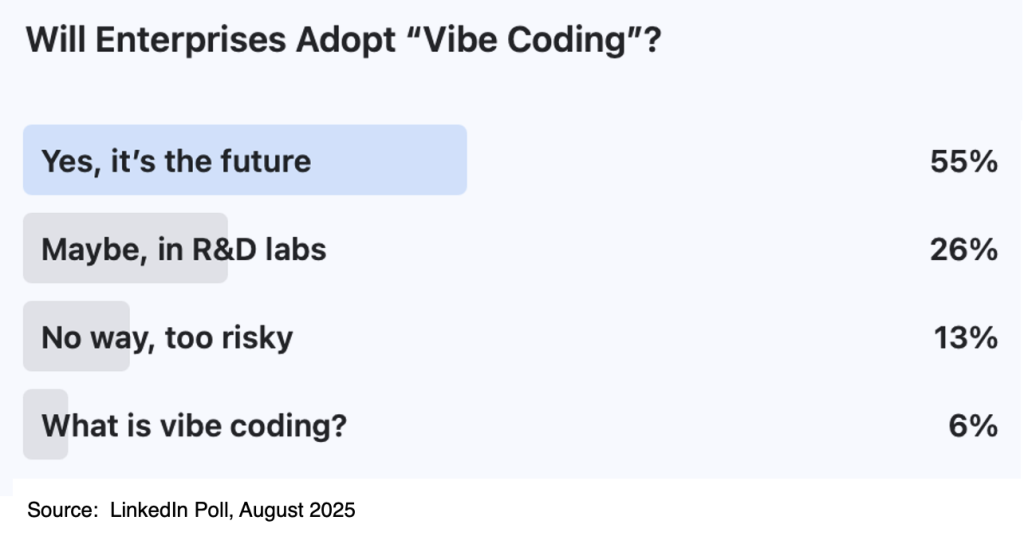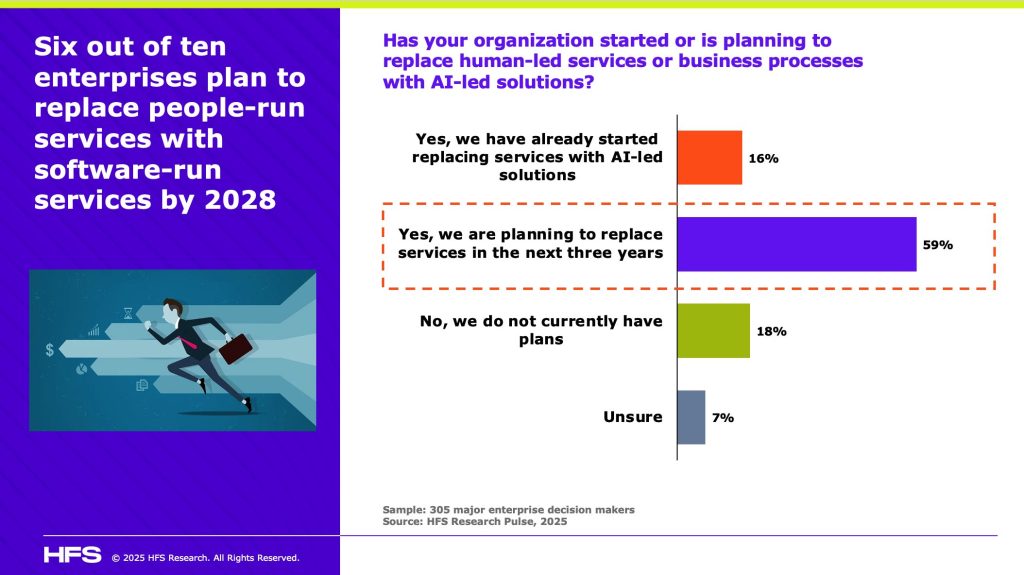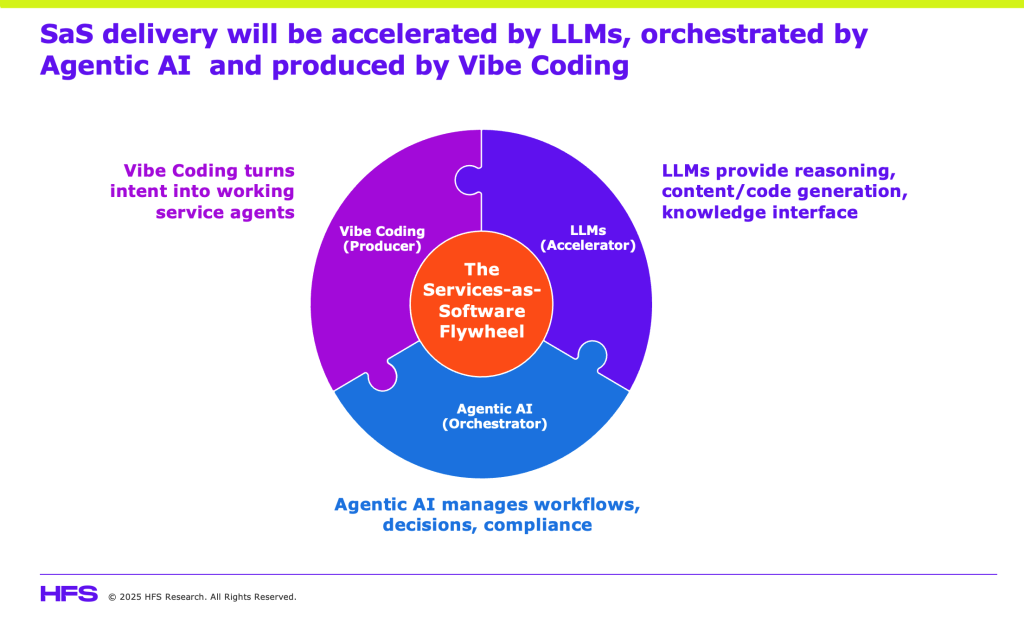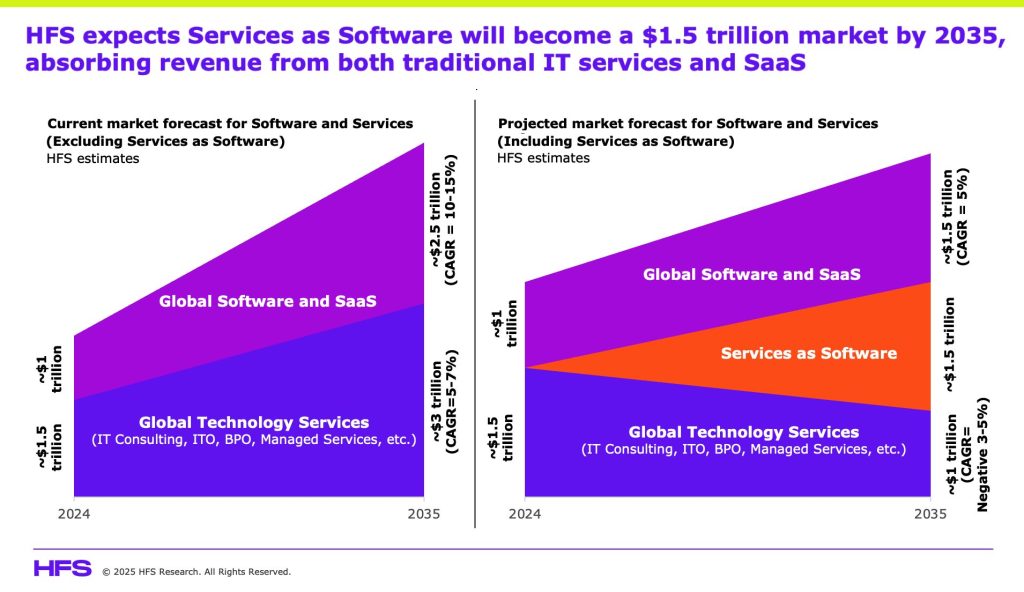Within three years, two-thirds of Global 2000 enterprises intend to replace human-heavy IT and BPO services with AI-driven delivery. At HFS, we are terming this Services-as-Software (SaS) and view the rapid progress of AI Agents, Large Language Models (LLMs) and, ultimately, Vibe Coding as the three technological catalysts to make this happen:
Why Services-as-Software will render many traditional services and software providers obsolete
Services-as-Software (SaS) is the fusion of software and services into AI-powered, outcome-driven platforms that continuously learn and adapt. SaS replaces static SaaS and labor-heavy consulting with autonomous digital service layers that deliver expertise and execution in real time. SaS will eventually render traditional labor-based professional services and traditional SaaS providers obsolete, replaced by scalable AI Agents that deliver outcomes, not hours or licenses.
SaS is an emerging enterprise model where human-delivered services are redesigned as intelligent, automated, and continuously adaptive software entities. Instead of buying static SaaS licenses or paying for labor-intensive services, enterprises consume AI-native service layers that blend automation, reasoning, and execution into outcome-based solutions.
SaS delivery will be accelerated by LLMs, orchestrated by Agentic AI, and produced by Vibe Coding
Services scaled in the past by combining talent with common tech platforms. In the SaS era, the same principle applies, but talent now needs deeper business context to unlock the value of common AI platforms.
Vibe Coding provides speed and intent, but it is the fusion with LLMs and Agentic AI that makes SaS sustainable:
- LLMs are the accelerator. It automates content, code, and workflow generation. Customers are already using it to shrink delivery cycles, generate reusable IP, and cut the cost of software testing.
- Agentic AI is the orchestrator. Multi-agent systems manage tasks, test outputs, retrain models, and monitor compliance. We see banks piloting agent-based compliance checks and insurers using them to orchestrate claims processing without armies of analysts.
- Vibe Coding is the production engine. It anchors intent-driven builds that can be refined, secured, and deployed like products. Large retailers are now expecting working demos within days of an engagement, driven by Vibe Coding copilots.
Together, these three AI constituents are replacing traditional FTE billing with subscription-based services, predictable costs, and outcome-linked value:
SaS blurs the line between software and services to form a $1.5 trillion industry
Like services, SaS delivers expertise and decision-making. Like software, it is automated, scalable, and subscription-based. But unlike either, it is dynamic, self-learning, and outcome-driven. This new category will absorb spend from both traditional SaaS and IT services, creating a $1.5 trillion market over the next few years, where enterprises stop paying for headcount or static tools and instead subscribe to AI-powered, adaptive outcomes:
What really is Vibe Coding?
Vice Coding is a new programming style that emphasizes rapid, intuitive and low-ceremony development. Developers and business stakeholders co-create with AI copilots through natural language, moving directly from intent to working code. It’s fast, conversational, and adaptive, designed for a world where software and services are fusing into dynamic, AI-driven outcomes. At HFS, we believe Vibe Coding will become the production engine behind the emerging Services-as-Software model, and we won’t even be calling it “vibe coding” in the future. It will all be about writing syntax to frame problems and design solutions. Let’s investigate further…
Vibe Coding offers the opportunity to realize the HFS OneOffice vision
For decades, business and IT have operated in silos — business leaders drafting requirements, IT translating them months later into code. This gap has slowed innovation and reinforced the divide between the front, middle, and back office.
Vibe Coding offers the opportunity to realize the HFS OneOffice vision. By enabling business stakeholders and developers to co-create with AI copilots in natural language, it collapses the wall between business intent and technology execution. Instead of handoffs, enterprises move in real time from idea to outcome. This is where business and IT finally come together as OneOffice: a unified, adaptive enterprise where technology and talent co-orchestrate value creation.
Those enterprises that simply think they can bolt on agentic technologies to their existing processes are quickly learning that this adds minimal value. It is like bolting a Tesla battery pack onto a lawnmower, where you can brag about the tech, but it will not cut the grass any faster. To gain the maximum benefits from AI technologies, business executives must work closely with their IT counterparts to design processes that generate the right data, make smarter decisions, and train people to use the technology effectively. The way we work is changing, both in terms of how processes function and how our roles need to broaden, as so many of our current tasks are improved or even replaced by AI.
Vibe Coding is not a lab experiment
Vibe Coding emphasizes speed, intuition, and iteration over rigid, process-heavy development. By reducing dependence on upfront design and exhaustive documentation, Vibe Coding enables teams to move directly from intent to working code in a conversational, adaptive way that aligns with the fast, fluid needs of modern enterprises.
Start-up funding organization Y Combinator reported that a quarter of its Winter 2025 startups had codebases that were 95 percent AI-generated. Production-ready components are now being built in hours instead of weeks. Governance, compliance, and security can be embedded into the codebase from the outset. Services, like software releases, can be built once and reused across multiple customers instead of bespoke projects. The consequences for service providers are profound.
Vibe Coding is the production engine that turns Services-as-Software from vision to reality
Services operated in the past by combining talent-at-scale with common tech platforms. In the SaS era, the same principles apply, but the talent needs deeper business context to unlock the value of common AI platforms.
Vibe Coding provides speed and intent, but it is the fusion with LLMs and Agentic AI that makes SaS sustainable:
- LLMs are the accelerator. It automates content, code, and workflow generation. Customers are already using it to shrink delivery cycles, generate reusable IP, and cut the cost of software testing.
- Agentic AI is the orchestrator. Multi-agent systems manage tasks, test outputs, retrain models, and monitor compliance. We see banks piloting agent-based compliance checks and insurers using them to orchestrate claims processing without armies of analysts.
- Vibe Coding is the production engine. It anchors intent-driven builds that can be refined, secured, and deployed like products. Large retailers are now expecting working demos within days of an engagement, driven by Vibe Coding copilots.
Together, these three AI constituents are replacing traditional FTE billing with subscription-based services, predictable costs, and outcome-linked value.
Enterprises mustn’t approach SaS as another outsourcing wave.
SaS is a new operating model and ambitious enterprise customers now expect working demos early in engagements, are exploring outcome-based contracts, and demand transparency on AI governance and intellectual property. This is the SaS vision coming to life in real time.
Smart enterprise leaders must stop measuring value in FTE counts and start anchoring contracts to speed, reuse, and reliability. That means asking providers for subscription-style pricing and demonstrable reuse of code and IP, not endless custom builds. It also means insisting on AI governance frameworks that explain how models are trained, how code is validated, and how intellectual property is protected.
CIOs must pivot their own talent strategies too. Developers and architects need to work with Vibe Coding and agentic systems rather than compete with them. Enterprises that invest in prompt engineering, AI-era architecture oversight, and code validation will extract the most value. Those that do not risk being locked into black-box services they cannot control or trust.
A global bank recently shifted from a traditional outsourcing contract to a SaS model for customer onboarding. Instead of hundreds of developers coding workflows, the provider now delivers an AI-powered onboarding service on subscription. Vibe Coding enables rapid iteration of new compliance checks, GenAI auto-generates the documentation, and Agentic AI monitors process accuracy. The bank gets faster releases, lower costs, and auditable governance, without the FTE treadmill.
Is vibe coding ready for prime time? Or stuck in lab?
To test the waters, we recently ran a LinkedIn poll asking: “Will enterprises adopt Vibe Coding?”

The results highlight both momentum and hesitation. The majority clearly see Vibe Coding as inevitable, drawn by its speed, adaptability, and ability to turn ideas into working code in days instead of months. Younger developers in particular are energised by its low-ceremony, conversational style, which plays to their comfort with AI-first tools.
But there is a tale of caution in the poll as well. Those who view Vibe Coding as risky because of:
- Governance & compliance gaps. Regulators and enterprises worry about how to audit code that is 95% AI-generated.
- Black-box outputs. Without explainability, enterprises fear vendor lock-in and an inability to validate outcomes.
- Talent disruption. Senior developers may resist low-ceremony, AI-first practices that threaten traditional roles.
- Security concerns. Copilots and LLMs trained on broad datasets raise questions about vulnerabilities and IP leakage.
- Cultural inertia. Shifting from documentation-heavy processes to conversational coding requires a new mindset that not all enterprises are ready for.
These concerns don’t negate the momentum, but they underline that adoption will depend on embedding governance, explainability, and trust at the core of Vibe Coding practices.
Recommendations for Enterprise Customers
- Shift contracting models. Move from FTE billing and static SaaS licenses to subscription-style, outcome-linked services.
- Invest in talent. Build new skills in prompt engineering, AI-era architecture, and code validation. Encourage younger talent to lead experiments with Vibe Voding, since they adapt fastest to conversational, AI-first ways of building.
- Demand transparency. Require providers to demonstrate AI governance frameworks, data lineage, and intellectual property protection.
- Push for reuse. Ask providers to deliver modular service components that can be reused across the enterprise, not bespoke one-offs.
- Pilot fast, scale faster. Expect working demos in days, not months, and measure providers on speed, reuse, and reliability.
Recommendations for Service Providers
- Retire the labor pyramid. Replace headcount-heavy delivery with AI-first, productized service agents built through Vibe Coding.
- Embed governance at the core. Bake compliance, security, and auditability into AI services from the outset.
- Industrialize Vibe Coding. Make copilots standard for all delivery teams and use young developers as the frontline to accelerate builds and generate reusable IP.
- Rewire pricing. Shift to subscription-based models that monetize outcomes, not hours.
- Partner widely. Team with hyperscalers, LLM vendors, and AI-native startups to co-create SaS offerings.
Recommendations for Traditional SaaS Firms
- Move beyond licenses. Static SaaS will be cannibalized. Pivot toward adaptive, AI-powered service layers that evolve continuously.
- Fuse with services. Collaborate with service providers to create co-delivered SaS platforms.
- Embrace Vibe Coding ecosystems. Open your platforms so developers, especially younger talent, can use AI copilots to extend and customize products in real time.
- Differentiate on trust. Put governance, privacy, and explainability at the center of your value proposition.
- Accelerate open platforms. Build marketplaces where Vibe Coding, Agentic AI, and LLM-powered agents extend your applications with speed and creativity.
Bottom line: Embrace vibe coding. Don’t fear it.
Vibe Coding is the production engine that makes Services-as-Software real, and it will decide the winners of the next decade. Enterprises can no longer afford to treat AI as bolt-ons or outsourcing-lite. SaS is a new operating model where AI agents, LLMs, and Vibe Coding collapse the gap between software and services, shifting the economics of IT from people and licenses to reusable, outcome-based digital service layers.
The real risk isn’t that Vibe Coding will fail; it’s that enterprises will fear it and do nothing, clinging to incremental improvements that are only slightly better, faster, or cheaper. Those who adapt now will own the future $1.5 trillion SaS market. Those who don’t will be stuck optimizing the old world, while others reinvent the new one.
To conclude, Vibe Coding is a new mindset that energizes young talent and accelerates the shift from human-run services to software-run outcomes. Enterprises, providers, and SaaS firms that embrace this culture will define the $1.5 trillion SaS market.
Posted in : Agentic AI, Analytics and Big Data, Artificial Intelligence, Automation, Business Data Services, Buyers' Sourcing Best Practices, ChatGPT, Digital OneOffice, Employee Experience, GenAI, Generative Enterprise, Lowcode Nocode, Vice Coding








